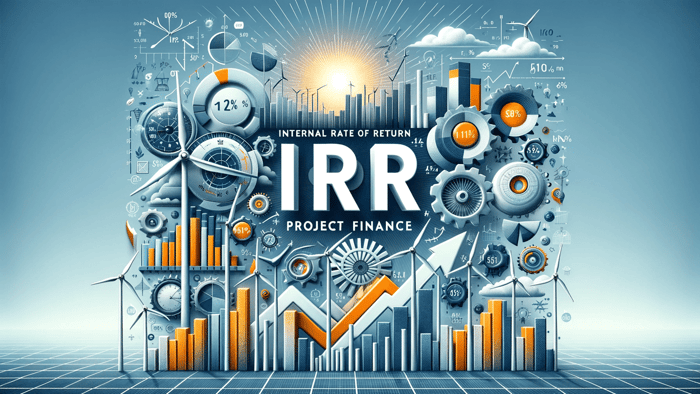A project finance deal is a complex transaction that brings together a diverse array of stakeholders, each playing a crucial role in ensuring the project's success. Whether you're a finance professional, a student, or someone curious about the mechanics of these deals, understanding the roles involved is crucial. In this article, we will explore the key participants in a project finance transaction and how their responsibilities interconnect to create a seamless operation.
Introduction to Key Roles in a Project Finance Deal
A project finance deal involves numerous stakeholders, each contributing specialized expertise and resources to structure, execute, and sustain the deal. These roles include financial institutions, advisors, legal entities, and technical specialists. By breaking down each role, you’ll gain a comprehensive understanding of their contributions and why their collaboration is essential.
Categorized Roles in Project Finance
1. Project Sponsors and Equity Investors
Project Sponsor: Initiates and oversees the project, providing equity investment and bearing significant risk.
Equity Investors: Provide capital in exchange for ownership stakes, sharing in the project's profits and losses.
2. Lenders and Financial Institutions
Bookrunner: Leads the syndication process and allocates the deal among lenders.
Primary Underwriter: Takes on the initial risk of underwriting the financing.
Mandated Lead Arranger (MLA): Structures the financing, arranges syndication, and secures commitments from other lenders.
Lead Arranger: Works alongside the mandated lead arranger to coordinate the transaction and negotiate terms.
Lenders: Provide debt financing, expecting repayment with interest from the project's cash flows.
Issuing Bank (for Letters of Credit): Issues letters of credit to guarantee payment obligations, enhancing the project's creditworthiness.
Fronting Bank (for Letters of Credit): Acts on behalf of the syndicate to issue letters of credit, especially when not all lenders can provide them directly.
Hedging Bank: Provides financial instruments to manage risks related to interest rates, currency exchange, or commodity prices.
Accounting Bank: Manages financial records, ensuring compliance with accounting standards and providing periodic financial statements.
3. Agents and Intermediaries
Administrative Agent: Manages the loan on behalf of the syndicate, handling communications, payments, and compliance monitoring.
Collateral Agent: Holds and manages collateral securing the loan, ensuring lenders' interests are protected.
Syndicator: Facilitates the distribution of loan portions among multiple lenders to spread risk.
Depositary Bank: Manages the project’s financial accounts and payment flows.
4. Advisory and Consultancy Services
Financial Advisors: Provide strategic advice on structuring and financing the project to optimize financial outcomes.
Technical Advisor/Independent Engineer: Assesses the project's technical feasibility and monitors construction and operational performance.
Market Advisor: Offers insights into market conditions, demand forecasts, and pricing strategies.
Legal Advisors:
Lender Legal Advisor: Protects lenders' legal rights, ensuring loan agreements and securities are properly structured.
Sponsor Legal Advisor: Represents the project sponsor's legal interests, drafting and negotiating contracts.
Insurance Advisor: Designs and implements insurance programs to mitigate various project risks.
Environmental Consultant: Ensures the project complies with environmental regulations and assesses potential environmental impacts.
Tax Advisor: Provides guidance on tax-efficient structuring and compliance with relevant tax laws.
5. Project Company and Operational Entities
Special Purpose Vehicle (SPV)/Project Company: A legal entity created solely for the project, isolating financial risk from the sponsors.
Operator: Manages the day-to-day operations of the project post-construction, ensuring efficient performance.
6. Regulatory and Supportive Institutions
Regulatory Agencies: Government bodies that oversee compliance with laws and regulations pertinent to the project.
Multilateral Agencies/Export Credit Agencies: Provide funding, guarantees, or insurance to support projects, especially in developing countries.
Insurance Providers: Offer coverage against risks such as property damage, liability, or business interruption.
Trustee: Administers bond issuance or trust arrangements.
7. Key Contractual Stakeholders and Service Providers
Power Purchase Agreement (PPA) Offtakers: Entities that agree to purchase the electricity generated by a power project under a long-term contract, providing revenue certainty for lenders and investors.
Engineering, Procurement, and Construction (EPC) Contractor: Responsible for designing, procuring materials, and constructing the project, typically under a fixed-price, turnkey contract.
Operations and Maintenance (O&M) Provider: Manages the ongoing operation of the project post-construction, including maintenance and repairs to ensure asset longevity and reliability.
Technical and Commercial Management Agreement (TCMA) Provider: Oversees both the technical and commercial aspects of the project, serving as a supervisory function over the O&M provider to ensure contractual and financial performance.
By organizing the roles into these categories, we can better appreciate the collaborative efforts required to successfully execute a project finance deal. Each participant plays a crucial part in navigating the complexities and ensuring the project's viability and profitability.
In-Depth Exploration of Roles
1. Project Sponsors and Equity Investors
Project sponsors and equity investors are the backbone of any project finance deal. They initiate the project and provide the critical equity capital that complements the debt financing. Their commitment and vision are essential for setting the project in motion.
Project Sponsor: This entity or group of entities is responsible for conceptualizing and overseeing the project. Sponsors are typically corporations, governments, or partnerships with a vested interest in the project's success. These sponsors are often developers who specialize in creating and delivering projects. Some sponsors aim to stay involved for the long term, focusing on operating the asset and generating recurring revenue. Others develop projects with the intention of selling them to equity investors or institutional buyers at a profit once the development phase is complete. What drives most sponsors is the potential for long-term profitability and strategic alignment with their business goals. Their key role is to ensure the project's feasibility, secure financing, and maintain oversight throughout the project lifecycle.
Equity Investors: These are individuals or institutional investors who provide equity capital in exchange for ownership stakes. They are driven by the opportunity to earn returns on their investment, either through dividends or capital appreciation. Their key role is to share the financial risk with lenders and sponsors, thereby reducing the overall financial burden on the project. Equity investors analyze key return metrics such as Internal Rate of Return (IRR) and Cash-on-Cash Return to assess the project's profitability. These figures help investors decide whether to commit capital to the project or seek better opportunities elsewhere. These metrics, combined with risk assessments, form the basis for their investment decisions.
2. Lenders and Financial Institutions
Lenders and financial institutions form the backbone of a project's financing structure, providing the necessary capital to execute large-scale projects. These entities assume varying degrees of risk and are compensated through interest payments or fees. Their involvement ensures liquidity and financial stability throughout the project's lifecycle.
Bookrunner: The bookrunner is the financial institution that leads the syndication process, working to allocate portions of the loan among participating lenders. They coordinate the transaction, manage marketing efforts, and set the structure of the deal. Bookrunners are driven by their role in establishing relationships with lenders and earning fees for successful syndication. Their key role is to ensure sufficient lender participation and secure commitments to fund the project.
Primary Underwriter: This party takes on the initial risk by underwriting the financing, guaranteeing the funds even if syndication efforts fall short. The primary underwriter ensures confidence in the transaction and acts as a bridge between the borrower and the financial market. They are driven by underwriting fees and the opportunity to build strong client relationships. Their key role is to underwrite the initial funding and stabilize the financial structure.
Mandated Lead Arranger (MLA): The MLA is responsible for structuring the financing, arranging the syndication process, and securing commitments from other lenders. MLAs are usually top-tier banks with strong market influence. They are driven by arranger fees and their reputation as leaders in structuring complex transactions. Their key role is to design the financial framework and negotiate terms with both lenders and borrowers.
Lead Arranger: Often working closely with the MLA, the lead arranger helps coordinate the transaction and negotiate terms with participants. They play a supporting role in syndication efforts and assist in bridging communication between parties. Lead arrangers are driven by participation fees and their stake in the deal's success. Their key role is to streamline the transaction process and support the MLA throughout the project finance deal.
Lenders: These are the financial institutions or entities that provide the actual debt capital for the project. Lenders are primarily driven by the repayment of their principal with interest, as well as fees associated with the loan agreement. Their key role is to fund the project and ensure that repayment terms are adhered to, often tied to the project's cash flow performance.
Issuing Bank (for Letters of Credit): The issuing bank guarantees payment obligations by issuing letters of credit (LCs). These instruments protect the project's stakeholders by ensuring that payments are made as agreed. Issuing banks are driven by fees and their role in mitigating counterparty risks. Their key role is to enhance the creditworthiness of the project and provide payment security.
Fronting Bank (for Letters of Credit): This entity acts on behalf of a syndicate to issue letters of credit, especially in situations where other lenders cannot provide them directly. Fronting banks ensure smooth operations in syndicated transactions and are an essential part of many project finance deals. They are driven by fees and their intermediary role. Their key role is to facilitate LC issuance while managing syndicate relationships.
Hedging Bank: The hedging bank provides financial instruments to manage risks associated with interest rates, currency exchange fluctuations, or commodity prices. Hedging banks are driven by fees for providing these services and their role in mitigating financial risks. Their key role in a project finance deal is to offer stability in the project's cash flow and shield the borrower from unfavorable market conditions.
Accounting Bank: The accounting bank is tasked with managing the project's financial records, ensuring compliance with accounting standards, and producing periodic financial statements. These banks are driven by their custodial and compliance responsibilities. Their key role is to maintain transparency and accuracy in the project's financial management.
3. Agents and Intermediaries
Agents and intermediaries serve as the backbone of project finance deals by ensuring smooth communication, transaction execution, and regulatory compliance. Their involvement ensures that the various financial and legal components of the deal function harmoniously.
Administrative Agent: The administrative agent is typically a bank or financial institution that manages the loan on behalf of the syndicate of lenders. They are responsible for handling communication between the borrower and lenders, monitoring compliance with loan agreements, and managing payments. Their key role is to act as the central coordinator ensuring all terms of the loan agreement are followed.
Collateral Agent: This agent holds and manages the collateral securing the loan, ensuring that lenders have a secured interest in the project’s assets. Collateral agents are responsible for enforcing security interests in case of default. Their key role is to ensure that lenders’ claims on project assets are legally protected.
Syndicator: The syndicator works to distribute portions of the loan among multiple lenders, allowing them to participate in the financing while spreading the risk. Their key role is to ensure adequate funding is secured by engaging a broad range of lending institutions.
Depositary Bank: This entity manages the project’s financial accounts, overseeing the flow of funds, ensuring proper allocation, and handling cash management. Their key role is to provide transparent financial administration for the project.
4. Advisory and Consultancy Services
Advisory and consultancy services play a critical role in structuring, optimizing, and ensuring the long-term viability of a project finance deal. These professionals provide expert guidance in areas such as financial structuring, technical feasibility, legal compliance, risk management, and environmental impact assessment. Their primary objective is to mitigate risks and maximize project efficiency.
Financial Advisors: These professionals assist the project sponsors in structuring the deal to optimize financing terms. Financial advisors analyze potential funding sources, assess risks, and structure debt-equity ratios to ensure financial sustainability. They also master complex project finance models to tailor the financial structure to the specific requirements of sponsors and banks, ensuring that all parties' risk appetites and return expectations are met. Their key role is to secure competitive financing options while balancing investor expectations and project feasibility.
Technical Advisor / Independent Engineer: Also referred to as the Independent Engineer, the technical advisor is responsible for assessing the project’s technical feasibility, reviewing engineering designs, and monitoring construction progress. They provide an independent assessment of technical risks and recommend solutions to ensure project completion within budget and on schedule. Their key role is to reassure lenders and investors about the technical soundness of the project.
Market Advisor: The market advisor analyzes energy markets, supply and demand conditions, and pricing forecasts (especially relevant for merchant energy projects). They provide insight into expected revenues and advise on potential market risks that could impact project viability. Their key role is to ensure that market assumptions used in financial models are realistic and robust.
Legal Advisors:
- Lender Legal Advisor: Represents the interests of lenders, ensuring that loan agreements, security structures, and contractual arrangements provide adequate protection. Their key role is to draft and negotiate agreements that safeguard lenders’ positions.
- Sponsor Legal Advisor: Represents the project sponsors in negotiations with lenders, government authorities, and contractors. Their key role is to ensure that the project’s legal framework aligns with the sponsor’s strategic and financial objectives.
Insurance Advisor: Works closely with project sponsors and lenders to develop an insurance strategy that mitigates financial losses from risks such as construction delays, equipment failures, and natural disasters. Their key role is to structure comprehensive insurance coverage that protects the project’s financial stability.
Environmental Consultant: Ensures the project meets environmental regulations and sustainability criteria. They conduct environmental impact assessments, propose mitigation measures, and ensure compliance with governmental and international environmental standards. Their key role is to help projects obtain necessary environmental permits and mitigate ecological risks.
Tax Advisor: Provides guidance on tax-efficient structuring, optimizing tax liabilities while ensuring compliance with local and international tax regulations. Tax advisors may recommend using shareholder loan structures as a strategy to optimize project financing from a tax standpoint, allowing sponsors to achieve more favorable tax treatment on interest payments. Their key role is to structure transactions in a way that minimizes tax burdens and maximizes after-tax returns.
These advisory and consultancy services collectively ensure that a project finance deal is structured optimally, financially viable, legally sound, and compliant with technical and environmental standards.
5. Project Company and Operational Entities
The project company and operational entities play a fundamental role in managing the project's execution, financial operations, and long-term sustainability. These entities ensure that the infrastructure is built, operated, and maintained efficiently while adhering to contractual obligations and financial commitments.
Special Purpose Vehicle (SPV) / Project Company: The SPV, also referred to as the project company, is a separate legal entity created solely for the purpose of developing, owning, and operating the project. By isolating financial risk from the sponsors, the SPV ensures that liabilities are limited to the project itself. The SPV enters into agreements with lenders, equity investors, contractors, and offtakers. Its key role is to act as the central hub for all financial flows and contractual arrangements, ensuring that the project operates within the financial and legal framework agreed upon.
Operator: The operator is responsible for the day-to-day management of the project once it is constructed and operational. Depending on the nature of the project, the operator may be an external firm specializing in asset management or an in-house subsidiary of the project sponsor. Their key responsibilities include maintaining infrastructure, ensuring regulatory compliance, and optimizing performance to maximize revenues. Operators are driven by operational efficiency and long-term asset performance, ensuring that the project remains viable throughout its lifespan.
The project company and its operational entities are essential for ensuring the success of a project finance deal. Their ability to execute the project effectively, manage risks, and generate steady cash flows is what ultimately determines the success of the financing structure.
6. Regulatory and Supportive Institutions
Regulatory and supportive institutions play a crucial role in ensuring compliance, mitigating risks, and providing financial stability for a project finance deal. These entities set the legal and financial framework within which projects must operate, offering regulatory oversight, financial guarantees, and risk mitigation strategies.
Regulatory Agencies: These government bodies oversee compliance with local and international laws, including environmental regulations, labor laws, and financial reporting standards. Regulatory agencies ensure that the project adheres to national policies, secures necessary permits, and follows industry standards. Their key role is to monitor compliance and enforce legal obligations to protect public and investor interests.
Multilateral Agencies / Export Credit Agencies (ECAs): Multilateral agencies such as the World Bank, International Finance Corporation (IFC), and regional development banks provide funding, guarantees, or technical assistance to support projects, particularly in emerging markets. Export Credit Agencies (ECAs) offer financing and risk insurance to support domestic companies engaged in international infrastructure projects. Their key role is to facilitate cross-border investments and improve financing conditions by reducing political and commercial risks.
Insurance Providers: Insurance firms play a key role in protecting project stakeholders from various risks, including property damage, business interruption, and political risks such as expropriation or regulatory changes. Insurance providers work closely with sponsors, lenders, and advisors to structure policies that mitigate financial losses. Their key role is to provide stability and risk mitigation mechanisms that enhance the bankability of the project.
Trustee: A trustee is typically an independent financial institution appointed to manage bond issuance, hold project assets on behalf of lenders, or ensure compliance with financing agreements. They act as an intermediary between borrowers and bondholders, safeguarding the interests of creditors. Their key role is to provide administrative oversight and enforce financial covenants in structured finance arrangements.
By ensuring legal compliance, reducing risks, and improving financing terms, regulatory and supportive institutions play a vital role in enabling successful project finance transactions.
7. Key Contractual Stakeholders and Service Providers
In addition to financial and regulatory entities, several contractual stakeholders play a fundamental role in the successful implementation and operation of a project finance deal. These stakeholders enter into long-term agreements that define the project’s revenue streams, construction, and operational framework.
Power Purchase Agreement (PPA) Offtakers:
PPA offtakers are entities that agree to purchase the electricity generated by a renewable or conventional power project under a long-term contract. These are often utilities, large corporations, or government agencies. Offtakers provide revenue certainty, which is crucial for lenders and investors. Their key role is to ensure predictable cash flows by committing to fixed-price power purchases over the project's life.Engineering, Procurement, and Construction (EPC) Contractor:
The EPC contractor is responsible for designing, procuring materials, and constructing the project. They typically operate under a fixed-price, turnkey contract to deliver the project on time and within budget. Their key role is to minimize construction risks and ensure the project meets technical specifications.Operations and Maintenance (O&M) Provider:
O&M providers manage the ongoing operation of the project post-construction. They are responsible for maintenance, repairs, and optimizing asset performance to ensure high availability and efficiency. Their key role is to maximize revenue by ensuring the project's long-term reliability.Technical and Commercial Management Agreement (TCMA) Provider:
The TCMA provider is responsible for overseeing both the technical and commercial aspects of the project. They ensure that the project operates efficiently from a technical perspective while also managing commercial obligations, such as contractual compliance, financial reporting, and revenue optimization. Additionally, the TCMA provider often serves as a supervisory function over the O&M provider, ensuring that maintenance and operational activities are performed in accordance with contractual obligations and performance benchmarks. Their key role is to act as an intermediary between the project's operational teams and financial stakeholders, ensuring that technical performance aligns with financial goals.
By integrating these contractual stakeholders, project finance deals can secure stable revenue streams, mitigate construction risks, and ensure long-term operational performance.
Conclusion
A project finance deal involves a vast network of participants, each with a defined role that contributes to the success of the transaction. From project sponsors and investors who provide the capital to lenders, advisors, and operational entities who ensure its execution, every stakeholder plays a crucial role in mitigating risks and maintaining financial stability. Regulatory and contractual stakeholders further enhance the structure by ensuring compliance and operational efficiency. Understanding these roles is essential for anyone involved in project finance, as their collaboration is what ultimately drives a project from inception to completion. By breaking down the responsibilities of each entity, we gain insight into how complex financial transactions are structured and managed, ensuring long-term success for all parties involved.
Renewables Valuation Analyst Program
In addition to the insights of who does what in a project finance deal, we invite you to explore the Renewables Valuation Analyst Program on our website.
The Renewables Valuation Analyst Program offers a focused and practical approach to mastering project finance deals and financial modeling for renewable energy projects. This specialized program is designed for those eager to develop their skills in building financial models from scratch, explicitly tailored to the renewables sector.
Key Highlights of the Program
- Core Focus on Financial Modeling: Learn the art of constructing detailed and robust financial models for renewable energy projects, starting from the ground up.
- Tailored to Renewable Energy: The curriculum is specifically designed around the nuances and specifics of renewable energy, including solar, wind, and other emerging technologies.
- Hands-On Learning Experience: Engage in practical exercises and real-world case studies that reinforce theoretical knowledge with practical application.
Benefits of Enrolling
- Skill Development: Gain proficiency in a critical skill set that is highly sought after in the renewable energy industry.
- Career Advancement: Elevate your professional value and open new career opportunities in a rapidly growing field.
- Industry Relevance: Stay ahead in an industry that increasingly relies on accurate and sophisticated financial modeling for decision-making and investment.
Push your career to the next level!
For professionals aiming to excel in renewable energy finance and project finance deals, the Renewables Valuation Analyst Program is an invaluable resource. It’s more than just a course; it’s a career investment, providing you with the tools and knowledge to build effective financial models specifically for the renewable energy sector. Join us to enhance your expertise and become a proficient financial modeler in the dynamic world of renewable energy.







